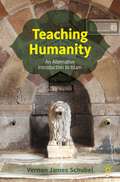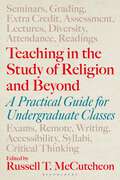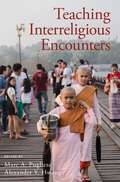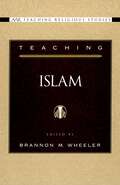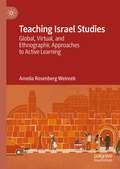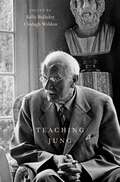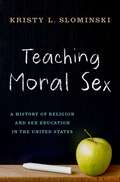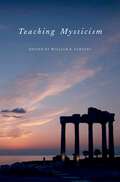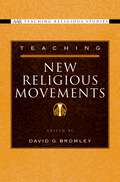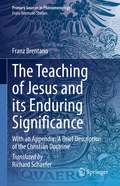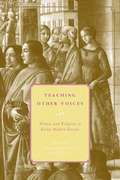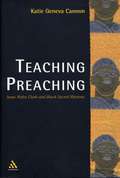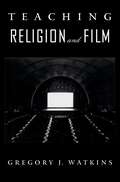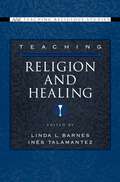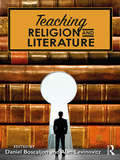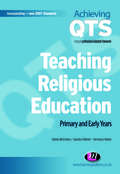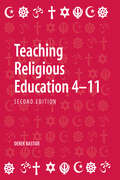- Table View
- List View
Teaching Humanity: An Alternative Introduction to Islam
by Vernon James SchubelThis book introduces Islam through a "humanistic" lens, by highlighting the affective traditions and expressions associated with Sufism and Shi'ism. While most introductory books emphasize the shari’a, and especially the “Five Pillars,” as the primary defining characteristic of Islam, Vernon James Schubel provides an alternative introduction which instead underscores the importance of humanity and the human being within Islamic thought and practice. The book stresses the diversity of Islamic beliefs and practices, presenting them as varied responses to the shared multivalent concepts of tawhid (the unity of God), nubuwwa (prophecy) and qiyama (the Day of Judgment). Readers are introduced to essential aspects of Islam including the life of the Prophet Muhammad, the Qur’an, the development of the shari‘a, and the emergence of the Sunni, Shi‘a and Sufi traditions. The book concludes with a call to redefine “mainstream” Islam, as a religious tradition focused on the centrality of love and rooted in the importance of humanity and universal human virtues.
Teaching in the Study of Religion and Beyond: A Practical Guide for Undergraduate Classes
by Russell T. McCutcheonDrawing on their wide experience in the undergraduate classroom, the contributors address basic but current issues in university teaching. This book provides practical commentary and invites instructors to consider how to address the learning needs of their students, while taking into account the wider structural requirements of administrations, governments, or credentialing agencies.Consisting of about forty, readable, short entries – on topics ranging from curriculum, grading, group work, digital humanities and large lectures, to learning management systems, office hours, online/remote courses, recruiting and seminars – this book provides a wealth of practical help and reassurance to teachers working with undergraduate students.This book is a valuable tool for early instructors in universities and colleges, showing them how to impact a class's success. It provides a critical background on the issues involved whilst also offering suggestions on how to navigate the competing demands on teachers.
Teaching in the Study of Religion and Beyond: A Practical Guide for Undergraduate Classes
Drawing on their wide experience in the undergraduate classroom, the contributors address basic but current issues in university teaching. This book provides practical commentary and invites instructors to consider how to address the learning needs of their students, while taking into account the wider structural requirements of administrations, governments, or credentialing agencies.Consisting of about forty, readable, short entries – on topics ranging from curriculum, grading, group work, digital humanities and large lectures, to learning management systems, office hours, online/remote courses, recruiting and seminars – this book provides a wealth of practical help and reassurance to teachers working with undergraduate students.This book is a valuable tool for early instructors in universities and colleges, showing them how to impact a class's success. It provides a critical background on the issues involved whilst also offering suggestions on how to navigate the competing demands on teachers.
Teaching Interreligious Encounters (AAR Teaching Religious Studies Series)
by Marc A. Pugliese and Alexander Y. HwangIn Teaching Interreligious Encounters, Marc A. Pugliese and Alexander Y. Hwang have gathered together a multidisciplinary and international group of scholar-teachers to explore the pedagogical issues that occur at the intersection of different religious traditions. This volume is a theoretical and practical guide for new teachers as well as seasoned scholars. It breaks the pedagogy of interreligious encounters down into five distinct components. In the first part, essays explore the theory of teaching these encounters; in the second, essays discuss course design. The parts that follow engage practical ideas for teaching textual analysis, practice, and real-world application. Despite their disciplinary, contextual, and methodological diversity, these essays share a common vision for the learning goals and outcomes of teaching interreligious encounters. This is a much-needed resource for any teacher participating in these conversations in our age of globalization and migration, with its attendant hopes and fears.
Teaching Interreligious Encounters (AAR Teaching Religious Studies Series)
In Teaching Interreligious Encounters, Marc A. Pugliese and Alexander Y. Hwang have gathered together a multidisciplinary and international group of scholar-teachers to explore the pedagogical issues that occur at the intersection of different religious traditions. This volume is a theoretical and practical guide for new teachers as well as seasoned scholars. It breaks the pedagogy of interreligious encounters down into five distinct components. In the first part, essays explore the theory of teaching these encounters; in the second, essays discuss course design. The parts that follow engage practical ideas for teaching textual analysis, practice, and real-world application. Despite their disciplinary, contextual, and methodological diversity, these essays share a common vision for the learning goals and outcomes of teaching interreligious encounters. This is a much-needed resource for any teacher participating in these conversations in our age of globalization and migration, with its attendant hopes and fears.
Teaching Islam (AAR Teaching Religious Studies)
by Brannon M. WheelerDespite the importance of Islam in global affairs and the role of Islamic Studies in Religious Studies, little attention has been given to the basic questions of how Islam should be taught. This volume brings together a number of leading scholars of Islamic Studies with rich experience in teaching Islam in a diversity of undergraduate settings, from large public universities to small private colleges. Topics addressed include Islamic law, the Quran, Sufism, women in Islam, Islam in America, and teaching about Islam through Arabic literature and the use of new information technology. Along with providing practical information about structuring courses and assignments, the contributors examine the place of Islamic Studies in the larger theoretical framework of Religious Studies and liberal arts curricula.
Teaching Israel Studies: Global, Virtual, and Ethnographic Approaches to Active Learning
by Amelia Rosenberg WeinrebThis book presents pedagogical strategies for today’s diverse Israel Studies classrooms. It offers Israel-specific innovations for online teaching, tested methods for organizing global virtual exchanges that uplift marginalized voices in Israel, including Palestinian voices, and an intellectual and political overview of the field. Informed by the author’s experiences in the classroom and principles shared with her by fellow instructors, the book provides a guide to developing an Israel Studies syllabus or integrating Israel Studies units into an existing curriculum
Teaching Jung (AAR Teaching Religious Studies)
by Kelly Bulkeley Clodagh WeldonSwiss psychologist Carl Jung (1875-1961) has made a major, though still contested, impact on the field of religious studies. Alternately revered and reviled, the subject of adoring memoirs and scathing exposes, Jung and his ideas have had at least as much influence on religious studies as have the psychoanalytic theories of his mentor, Sigmund Freud. Teaching Jung offers a collection of original articles presenting several different approaches to Jung's psychology in relation to religion, theology, and contemporary culture. The contributors describe their teaching of Jung in different academic contexts, with special attention to the pedagogical and theoretical challenges that arise in the classroom. Many of Jung's key psychological terms (archetypes, collective unconscious, individuation, projection, synchronicity, extroversion and introversion) have become standard features of religious studies discourse, and his extensive commentaries on various religious traditions make it clear that Jung's psychology is, at one level, a significant contribution to the study of human religiosity. His characterization of depth psychology as a fundamentally religious response to the secularizing power of modernity has left a lasting imprint on the relationship between religious studies and the psychological sciences.
Teaching Moral Sex: A History of Religion and Sex Education in the United States
by Kristy L. SlominskiWhose job is it to teach the public about sex? Parents? The churches? The schools? And what should they be taught? These questions have sparked some of the most heated political debates in recent American history, most recently the battle between proponents of comprehensive sex education and those in favor of an "abstinence-only" curriculum. Kristy Slominski shows that these questions have a long, complex, and surprising history. Teaching Moral Sex is the first comprehensive study of the role of religion in the history of public sex education in the United States. The field of sex education, Slominski shows, was created through a collaboration between religious sex educators-primarily liberal Protestants, along with some Catholics and Reform Jews-and "men of science"-namely physicians, biology professors, and social scientists. She argues that the work of early religious sex educators laid the foundation for both sides of contemporary controversies that are now often treated as disputes between "religious" and "secular" Americans. Slominski examines the religious contributions to national sex education organizations from the late nineteenth century to the early twenty-first. Far from being a barrier to sex education, she demonstrates, religion has been deeply embedded in the history of sex education, and its legacy has shaped the terms of current debates. Focusing on religion uncovers an under-recognized cast of characters-including Quaker and Unitarian social purity reformers, military chaplains, and the Young Men's Christian Association- who, Slominski deftly shows, worked to make sex education more acceptable to the public through a strategic combination of progressive and restrictive approaches to sexuality. Teaching Moral Sex highlights the essential contributions of religious actors to the movement for sex education in the United States and reveals where their influence can still be felt today.
Teaching Moral Sex: A History of Religion and Sex Education in the United States
by Kristy L. SlominskiWhose job is it to teach the public about sex? Parents? The churches? The schools? And what should they be taught? These questions have sparked some of the most heated political debates in recent American history, most recently the battle between proponents of comprehensive sex education and those in favor of an "abstinence-only" curriculum. Kristy Slominski shows that these questions have a long, complex, and surprising history. Teaching Moral Sex is the first comprehensive study of the role of religion in the history of public sex education in the United States. The field of sex education, Slominski shows, was created through a collaboration between religious sex educators-primarily liberal Protestants, along with some Catholics and Reform Jews-and "men of science"-namely physicians, biology professors, and social scientists. She argues that the work of early religious sex educators laid the foundation for both sides of contemporary controversies that are now often treated as disputes between "religious" and "secular" Americans. Slominski examines the religious contributions to national sex education organizations from the late nineteenth century to the early twenty-first. Far from being a barrier to sex education, she demonstrates, religion has been deeply embedded in the history of sex education, and its legacy has shaped the terms of current debates. Focusing on religion uncovers an under-recognized cast of characters-including Quaker and Unitarian social purity reformers, military chaplains, and the Young Men's Christian Association- who, Slominski deftly shows, worked to make sex education more acceptable to the public through a strategic combination of progressive and restrictive approaches to sexuality. Teaching Moral Sex highlights the essential contributions of religious actors to the movement for sex education in the United States and reveals where their influence can still be felt today.
Teaching Mysticism (AAR Teaching Religious Studies)
by William B. ParsonsThe term ''mysticism'' has never been consistently defined or employed, either in religious traditions or in academic discourse. The essays in this volume offer ways of defining what mysticism is, as well as methods for grappling with its complexity in a classroom. This volume addresses the diverse literature surrounding mysticism in four interrelated parts. The first part includes essays on the tradition and context of mysticism, devoted to drawing out and examining the mystical element in many religious traditions. The second part engages traditions and religio-cultural strands in which ''mysticism'' is linked to other terms, such as shamanism, esotericism, and Gnosticism. The volume's third part focuses on methodological strategies for defining ''mysticism,'' with respect to varying social spaces. The final essays show how contemporary social issues and movements have impacted the meaning, study, and pedagogy of mysticism. Teaching Mysticism presents pedagogical reflections on how best to communicate mysticism from a variety of institutional spaces. It surveys the broad range of meanings of mysticism, its utilization in the traditions, the theories and methods that have been used to understand it, and provides critical insight into the resulting controversies.
Teaching Mysticism (AAR Teaching Religious Studies)
The term ''mysticism'' has never been consistently defined or employed, either in religious traditions or in academic discourse. The essays in this volume offer ways of defining what mysticism is, as well as methods for grappling with its complexity in a classroom. This volume addresses the diverse literature surrounding mysticism in four interrelated parts. The first part includes essays on the tradition and context of mysticism, devoted to drawing out and examining the mystical element in many religious traditions. The second part engages traditions and religio-cultural strands in which ''mysticism'' is linked to other terms, such as shamanism, esotericism, and Gnosticism. The volume's third part focuses on methodological strategies for defining ''mysticism,'' with respect to varying social spaces. The final essays show how contemporary social issues and movements have impacted the meaning, study, and pedagogy of mysticism. Teaching Mysticism presents pedagogical reflections on how best to communicate mysticism from a variety of institutional spaces. It surveys the broad range of meanings of mysticism, its utilization in the traditions, the theories and methods that have been used to understand it, and provides critical insight into the resulting controversies.
Teaching New Religious Movements (AAR Teaching Religious Studies)
by David G. BromleySince its inception around 1970, the study of New Religious Movements (NRMs) has evolved into an established multidisciplinary field. At the same time, both the movements and the scholars who study them have been the subjects of intense controversy. In this volume, a group of senior NRM scholars who have been instrumental in the development of the field will offer pivotal essays that present the basics of NRM scholarship along with guidance for teachers on classroom use. The book is organized topically around subjects that are both central to the study of NRMs and likely to be useful to non-specialists. Part I contains examinations of the definitional boundaries of the area of study, varying disciplinary perspectives on NRMs, unique methodological/ethical problems encountered in the study of NRMs, and the controversies that have confronted scholars studying NRMs and the movements themselves. Part II examines a series of topics central to teaching about NRMs: the larger sociocultural significance of the movements, their distinctive symbolic and organizational features, the interrelated processes of joining and leaving NRMs, the organization of gender roles in NRMs, media and popular culture portrayals of the movements, the occurrence of corruption and abuse within movements, and violence by and against NRMs. Part III provides informational resources for teaching about NRMs, which are particularly important in a field where knowing the biases of sources is crucial. With its interdisciplinary approach, the volume provides comprehensive, accessible information and perspectives on NRMs. It is an invaluable guide for instructors navigating this scholarly minefield.
The Teaching of Jesus and its Enduring Significance: With an Appendix: 'A Brief Description of the Christian Doctrine' (Primary Sources in Phenomenology)
by Franz BrentanoHere, for the first time in English, is Franz Brentano’s The Teaching of Jesus, a compendium of texts Brentano assembled for publication shortly before his death that constitute a frank, public settling of accounts with the Christian religion. Originally conceived by Brentano as a volume that might help others similarly led to doubt the doctrines of Christianity, the book is remarkably free of bitterness or spitefulness. On the contrary, what makes the book of singular importance, especially now, is its careful attempt at taking stock of the positive and negative influence Christianity has had in history. This text appeals to those researchers and scholars interested in the work of Franz Brentano and his work on the philosophy of religion, in this case, Christianity.
Teaching Other Voices: Women and Religion in Early Modern Europe
by Margaret L. King Albert RabilThe books in The Other Voice in Early Modern Europe series chronicle the heretofore neglected stories of women between 1400 and 1700 with the aim of reviving scholarly interest in their thought as expressed in a full range of genres: treatises, orations, and history; lyric, epic, and dramatic poetry; novels and novellas; letters, biography, and autobiography; philosophy and science. Teaching Other Voices: Women and Religion in Early Modern Europe complements these rich volumes by identifying themes useful in literature, history, religion, women's studies, and introductory humanities courses. The volume's introduction, essays, and suggested course materials are intended as guides for teachers--but will serve the needs of students and scholars as well.
Teaching Other Voices: Women and Religion in Early Modern Europe
by Margaret L. King Albert RabilThe books in The Other Voice in Early Modern Europe series chronicle the heretofore neglected stories of women between 1400 and 1700 with the aim of reviving scholarly interest in their thought as expressed in a full range of genres: treatises, orations, and history; lyric, epic, and dramatic poetry; novels and novellas; letters, biography, and autobiography; philosophy and science. Teaching Other Voices: Women and Religion in Early Modern Europe complements these rich volumes by identifying themes useful in literature, history, religion, women's studies, and introductory humanities courses. The volume's introduction, essays, and suggested course materials are intended as guides for teachers--but will serve the needs of students and scholars as well.
Teaching Preaching: Isaac Rufus Clark and Black Sacred Rhetoric
by Katie Geneva Cannon"If you ain't got no proposition, you ain't got no sermon neither." This was the battle cry of Isaac Rufus Clark, one of the most influential and colorful professors of homiletics in the black church in the twentieth century. Clark taught at the Interdenominational Theological Center in Atlanta for twenty-seven years (1962-1989). In Teaching Preaching, Katie Cannon, one of Clark's myriad preaching protégés, conceives her role as purely "presentational": "to bring Clark face to face with a reading audience, allow him to explain the formal elements of preaching from the inside out." Teaching Preaching is an invaluable resource for ministers who struggle from Sunday to Sunday to find their ethical voice in the preparation of each and every sermon.
Teaching Religion and Film (An American Academy of Religion Book)
by Gregory J WatkinsIn a culture increasingly focused on visual media, students have learned not only to embrace multimedia presentations in the classroom, but to expect them. Such expectations are perhaps more prevalent in a field as dynamic and cross-disciplinary as religious studies, but the practice nevertheless poses some difficult educational issues -- the use of movies in academic coursework has far outpaced the scholarship on teaching religion and film. What does it mean to utilize film in religious studies, and what are the best ways to do it? In Teaching Religion and Film, an interdisciplinary team of scholars thinks about the theoretical and pedagogical concerns involved with the intersection of film and religion in the classroom. They examine the use of film to teach specific religious traditions, religious theories, and perspectives on fundamental human values. Some instructors already teach some version of a film-and-religion course, and many have integrated film as an ancillary to achieving central course goals. This collection of essays helps them understand the field better and draws the sharp distinction between merely "watching movies" in the classroom and comprehending film in an informed and critical way.
Teaching Religion and Healing (AAR Teaching Religious Studies)
by Linda L. BarnesThe study of medicine and healing traditions is well developed in the discipline of anthropology. Most religious studies scholars, however, continue to assume that "medicine" and "biomedicine" are one and the same and that when religion and medicine are mentioned together, the reference is necessarily either to faith healing or bioethics. Scholars of religion also have tended to assume that religious healing refers to the practices of only a few groups, such as Christian Scientists and pentecostals. Most are now aware of the work of physicians who attempt to demonstrate positive health outcomes in relation to religious practice, but few seem to realize the myriad ways in which healing pervades virtually all religious systems. This volume is designed to help instructors incorporate discussion of healing into their courses and to encourage the development of courses focused on religion and healing. It brings together essays by leading experts in a range of disciplines and addresses the role of healing in many different religious traditions and cultural communities. An invaluable resource for faculty in anthropology, religious studies, American studies, sociology, and ethnic studies, it also addresses the needs of educators training physicians, health care professionals, and chaplains, particularly in relation to what is referred to as "cultural competence" - the ability to work with multicultural and religiously diverse patient populations.
Teaching Religion and Healing (AAR Teaching Religious Studies)
The study of medicine and healing traditions is well developed in the discipline of anthropology. Most religious studies scholars, however, continue to assume that "medicine" and "biomedicine" are one and the same and that when religion and medicine are mentioned together, the reference is necessarily either to faith healing or bioethics. Scholars of religion also have tended to assume that religious healing refers to the practices of only a few groups, such as Christian Scientists and pentecostals. Most are now aware of the work of physicians who attempt to demonstrate positive health outcomes in relation to religious practice, but few seem to realize the myriad ways in which healing pervades virtually all religious systems. This volume is designed to help instructors incorporate discussion of healing into their courses and to encourage the development of courses focused on religion and healing. It brings together essays by leading experts in a range of disciplines and addresses the role of healing in many different religious traditions and cultural communities. An invaluable resource for faculty in anthropology, religious studies, American studies, sociology, and ethnic studies, it also addresses the needs of educators training physicians, health care professionals, and chaplains, particularly in relation to what is referred to as "cultural competence" - the ability to work with multicultural and religiously diverse patient populations.
Teaching Religion and Literature
by Daniel Boscaljon Alan LevinovitzTeaching Religion and Literature provides a practical engagement with the pedagogical possibilities of teaching religion courses using literature, teaching literature classes using religion, and teaching Religion and Literature as a discipline. Featuring chapters written by award winning teachers from a variety of institutional settings, the book gives anyone interested in providing interdisciplinary education a set of questions, resources, and tools that will deepen a classroom’s engagement with the field. Chapters are grounded in specific texts and religious questions but are oriented toward engaging general pedagogical issues that allow each chapter to improve any instructor’s engagement with interdisciplinary education. The book offers resources to instructors new to teaching Religion and Literature and provides definitions of what the field means from senior scholars in the field. Featuring a wide range of religious traditions, genres, and approaches, the book also provides an innovative glimpse at emerging possibilities for the sub-discipline.
Teaching Religion and Literature
by Daniel Boscaljon Alan LevinovitzTeaching Religion and Literature provides a practical engagement with the pedagogical possibilities of teaching religion courses using literature, teaching literature classes using religion, and teaching Religion and Literature as a discipline. Featuring chapters written by award winning teachers from a variety of institutional settings, the book gives anyone interested in providing interdisciplinary education a set of questions, resources, and tools that will deepen a classroom’s engagement with the field. Chapters are grounded in specific texts and religious questions but are oriented toward engaging general pedagogical issues that allow each chapter to improve any instructor’s engagement with interdisciplinary education. The book offers resources to instructors new to teaching Religion and Literature and provides definitions of what the field means from senior scholars in the field. Featuring a wide range of religious traditions, genres, and approaches, the book also provides an innovative glimpse at emerging possibilities for the sub-discipline.
Teaching Religious Education
by Elaine Mccreery Sandra Palmer Veronica VoielsMany trainee primary teachers are uncertain as to the place and purpose of RE in primary schools. This book is designed to alleviate such fears and give trainees the security and confidence to teach RE effectively. Trainees are encouraged to recognise their own religious position and understand how they handle their own beliefs and commitments in the classroom. In addition, they will learn how to be sensitive to children's religious viewpoints, allowing children to share their beliefs in a secure and supportive environment. A range of strategies help readers to provide engaging and appropriate RE across the primary age phase.
Teaching Religious Education 4-11
by Derek BastideThis long-awaited second edition is an accessible, practical guide for primary teachers. It covers the teaching of religious education at the Foundation Stage, Key Stage 1 and Key Stage 2. Taking account of the changes to RE over the last decade, it maps out and considers the implications for teachers of: changes that have taken place over the last few years with regard to changing aims and objectives in the subject the legal framework the broadening understanding of the notion of religion concern for spiritual development emergence of citizenship as an additional component of the curriculum introduction of formal guidelines to the content of RE teaching Christianity and other world faiths tackling important topics and contemporary issues planning RE across the primary school planning a unit of work using different teaching approaches monitoring and assessing progress. The book is full of practical examples and will also contain a uesful resources section. In addition there will be a chapter on key religions, which will look at Buddhism, Christianity, Hinduism, Islam, Judaism and Sikhism.
